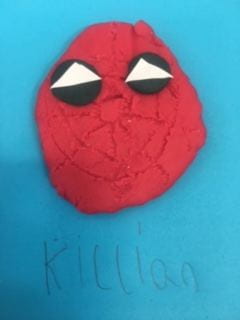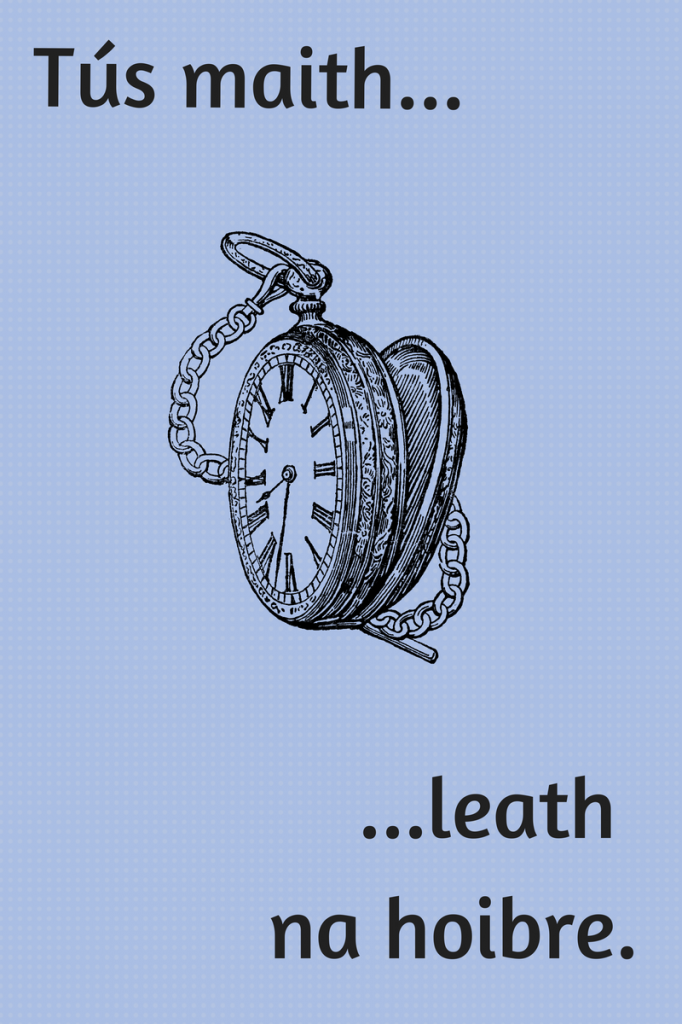
Author: merrybeau
Who’s = a contraction. What is a contraction?
‘New Wave English in Practice’ is a book you use every day.

The same kind of questions come up day after day.
This is good.

Over time you learn how to do the harder questions.
Then you get to practice these questions again and again.

Spelling rules, pronunciation and grammar are practised in other ways too:

Many children have been finding the difference between ‘who’s’ and ‘whose’ difficult.
This post will help you learn the difference.

But before you can learn the difference between ‘who’s’ and ‘whose’, you need to learn about ‘contractions‘.
There are questions about contractions in New Wave English too.

When you stretch the rubber band, it expands;
when you let it go, it contracts.
That’s what we’re doing when we contract words – we’re just making words smaller.

PublicDomainPictures / Pixabay
Here is a short video that explains contractions, what we do when we contract words, when we make words smaller.
And because practice makes perfect, here is another one. We hope that this animation will help you remember what a contraction is.
It is always a good idea to go back over what you have learnt.
We call this revision.
Here is another short video. It revises what you have just learnt.
After learning anything new, it is a good idea to practice it. Here is a chance to do just that.
If you still found contractions hard you can click on THIS link for another video.
Now you have learned what a contraction is, you are one step closer to understanding the difference between …
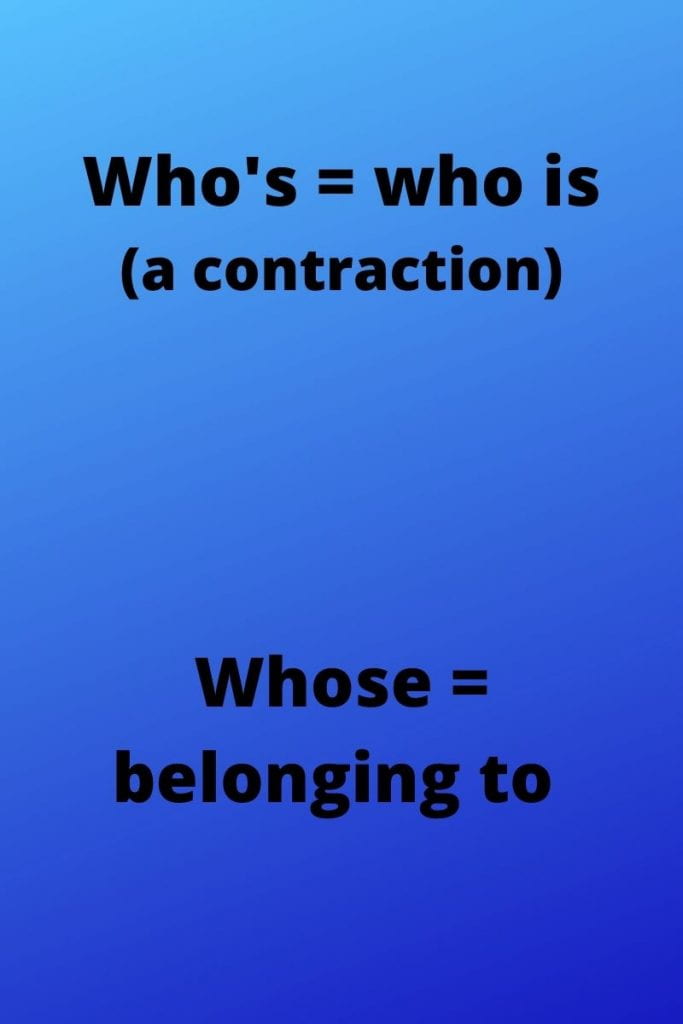
Because
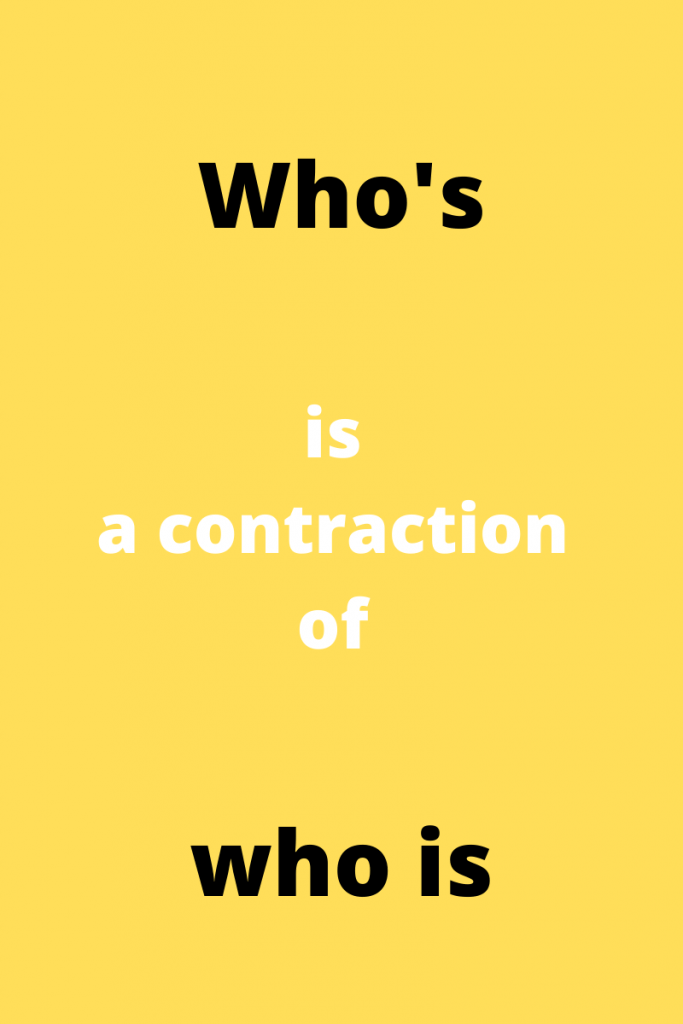
Remember if there is a question in New Wave English about who’s and whose ask yourself

If who has or who is does not make sense ask yourself:

That is enough information for one post. Click HERE if you want to learn more about

The difference between ‘Who’s’ and ‘Whose’
In New Wave English children have been working on the difference between

Here we are going to learn about

In English grammar ‘Whose’ is called a possessive pronoun’.
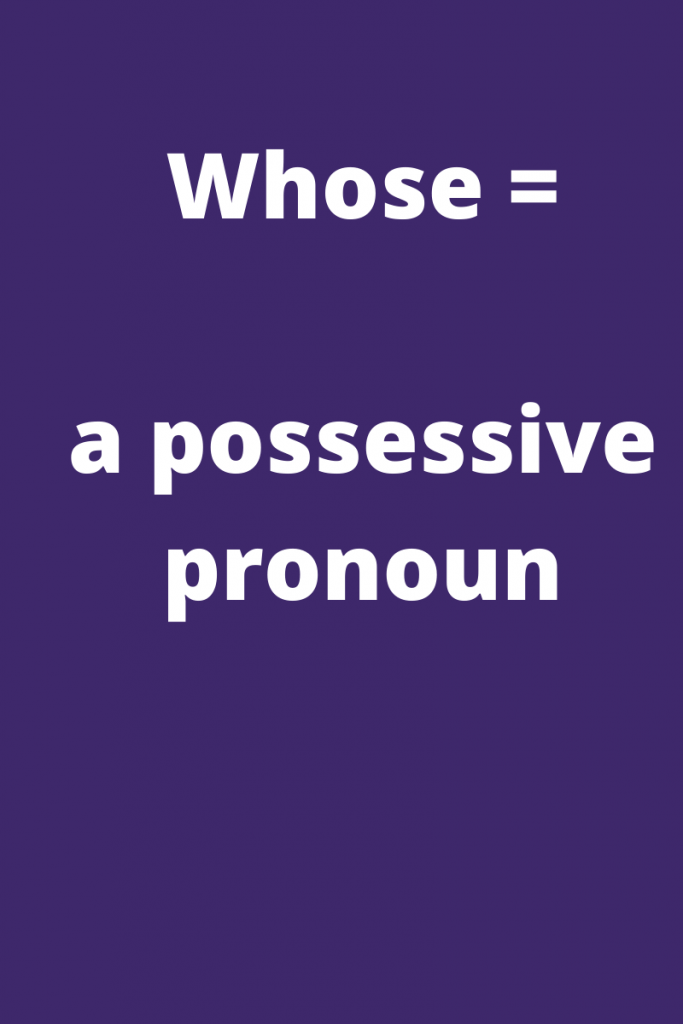
Here is a short video to help you tell the difference between who’s and whose:
And here is a very quick revision video
Now let’s try some practice:
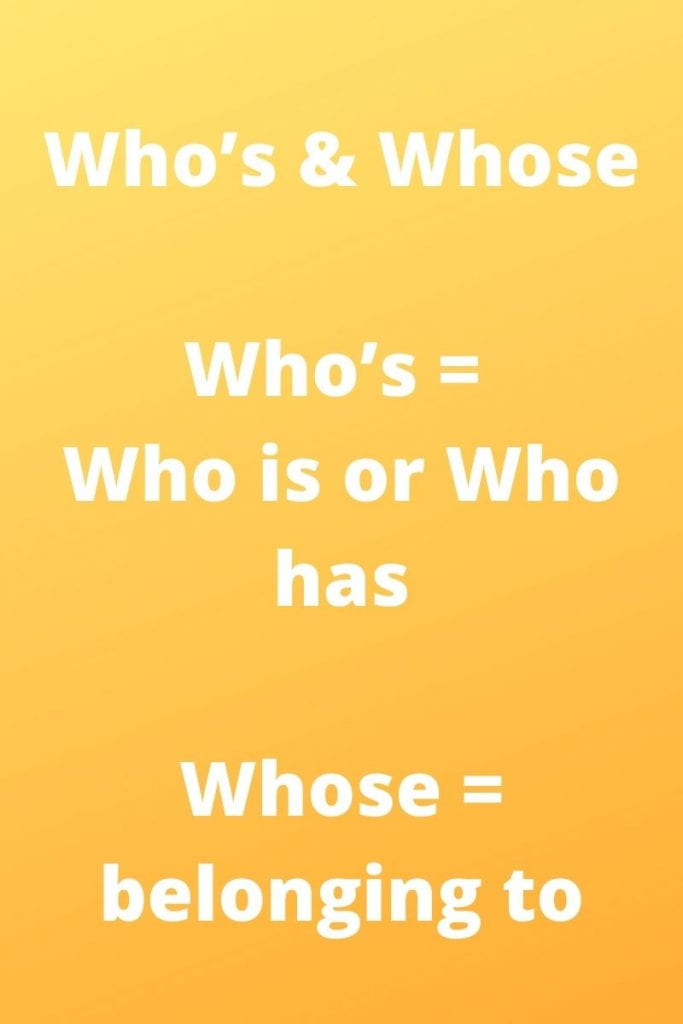
Is it who’s or whose?
1. ___ a wise owl?
2. ___ coat was left in the yard?
3. ___ going to draw an picture today?
4. ___ dog can do tricks?
5. ___ little sister is in preschool?
6. ___ your favorite sports star?
7. ___ going to get exercise after school today?
8. ___ going to help at home today?
9. ___ new shoes are those?
10. ___ the best class ever?
The answers are HERE.
Bossy ‘R@: The sounds made by -ar -er, -ir and -ur.
When students are doing their ‘New Wave English’
we notice that they can find Question One tricky.
Question One is about pronunciation and spelling rules.
Here is a video to help.
It is about the sound made by -er, -ir and -ur.
When the vowels e, i and u are followed by the letter ‘r’ it changes their sound.
In younger classes, this is often called the ‘Bossy R’ rule.
Another way you can get better at doing Questions One is reading.
You will see words spelt correctly in your reading books.
So you will get better at knowing if a word is spelt right.
You will see -er, -ir and -ur words when you read too.
Practice makes perfect.
Useful videos about Parts of Speech: Nouns, Verbs, Adverbs, Adjectives, Pronouns, Interjections, Prepositions and Conjunctions
Parts of Speech poem
English: Help with the tricky stuff from the work children are doing: Verbs and other parts of speech
Dear Parents,
Sometimes questions are asked in New Wave English about parts of speech.
Further down the page are some online activities for learning about and revising parts of speech
like nouns, adjectives and verbs.
But first, let’s go back over what they are:
NOUNS

Jorgeduardo / Pixabay
nouns = naming words
Nouns are the name of a person, place or thing
e.g. Superman, Greystones and spaceship
Superman, Greystones and spaceship are all nouns or naming words
The rule of thumb we use when first teaching nouns is:
If you can take a photo of it, it is a noun.

Simon / Pixabay
Here is a video about nouns:
ADJECTIVES

perianjs / Pixabay
adjectives = a describing word
e.g. brave Superman, beautiful Greystones, speedy spaceship
Brave, beautiful and speedy are all adjectives.
They describe the nouns.
Click HERE to see a short video that teaches about adjectives
VERBS

anaterate / Pixabay
verbs = action words
Superman flies. We live in Greystones. The spaceship whizzed by.
In these sentences, flies, live and whizzed are all verbs or action words.
Click HERE to see a short video that explains what verbs are.
Here are FIVE online activities to practice nouns, adjectives and verbs.
1.
Click on the this link for the BALLOON NOUN GAME
2.
Click on this link to play the same game but this time about BALLOON VERB GAME
3.
Click HERE to practice both nouns and verbs.
See what happens the monkey gets ten scoops of icecream in a row!
You can play three in different ways: Nouns only, Verbs only or both Nouns and Verbs
4.
Click HERE to practice different parts of speech.
Untick the boxes leaving just nouns and verbs to practice them.
To play stop the asteroids from crashing into the planet.
5.
Click HERE for Word Shark a game that goes back over Nouns, Adjectives and Verbs
Finally this short video goes back over Nouns, Adjectives and Verbs just to make sure you remember what they are.
We hope this helps you learn about Nouns, Adjectives and Verbs.
What was your favourite game for learning about Nouns, Adjectives and Verbs?
If you let us know we will see if we can find more like it.
How about a break ?

Lepale / Pixabay
Chapter 1 https://vimeo.com/410338545
|
Chapter book
vimeo.com
|
Chapter 2 https://vimeo.com/412839836
|
This is “Chapter 2-The Owl Who Was Afraid of the Dark” by The Berkeley School Faculty on Vimeo, the home for high quality videos and the people who love them.
vimeo.com
|
Chapter 3 https://vimeo.com/412895127
|
This is “Chapter 3- The Owl Who was Afraid of the Dark” by The Berkeley School Faculty on Vimeo, the home for high quality videos and the people who love…
vimeo.com
|
Chapter 4 https://vimeo.com/414964789
|
Dark Is Necessary
vimeo.com
|
Chapter 5 https://vimeo.com/415385837
|
Dark Is Fascinating
vimeo.com
|
CLICK HERE for Chapter 6 https://vimeo.com/417479559
|
Dark is Beautiful
vimeo.com
|

You know in order to read fluently not to read like a robot 😉
Gymnastics for the Brain.

The Class Story on Class Dojo was getting a little confusing with all the brain teasers. Sometimes it was hard to see the class teacher’s school work. So you will find the brain teasers here instead:
20 Questions. The answers are below.
- Q: What gets wetter the more it dries?
- Q: A cowboy rode into town on Tuesday. He stayed in town for three days and rode out on Tuesday. How was that possible?
- Q: What has to be broken before you can use it?
- Q: What belongs to you but is used more by others?
- Q: What goes up and never comes down?
- Q: I’m full of keys but I can’t open any door. What am I?
- Q: I’m light as a feather, yet the strongest man can’t hold me for more than 5 minutes. What am I?
- Q: Can you name three consecutive days without using the words Wednesday, Friday, and Sunday?
- Q: Jimmy’s mother had three children. The first was named April, the next was named May. What was the name of the third child?
- Q: What kind of coat can only be put on when wet?
- Q: What occurs once in a minute, twice in a moment, and never in one thousand years?
- Q: What runs, but never walks, often murmurs – never talks, has a bed but never sleeps, has a mouth but never eats?
- Q: What gets sharper the more you use it?
- Q: If I have it, I don’t share it. If I share it, I don’t have it. What is it?
- Q: What word is spelled wrong in every dictionary?
- Q: What has a thumb and four fingers but is not alive?
- Q: What do the numbers 11, 69, and 88 all have in common?
- Q: I am an odd number. Take away one letter and I become even. What number am I?
- Q: If you multiply me by any other number, the answer will always remain the same. What number am I?
- Q: What five-letter word becomes shorter when you add two letters to it?
Answers to the 20 Questions
- A towel
- Tuesday was the name of his horse.
- An egg.
- Your name.
- Your age.
- A piano.
- Breath.
- Yesterday, today, and tomorrow.
- Jimmy of course!
- A coat of paint.
- The letter M.
- A river.
- Your brain.
- A secret.
- The word “wrong!”
- A glove.
- They read the same right side up and upside down.
- Seven (take away the ‘s’ and it becomes ‘even’).
- Zero.
- The word is ‘short’.
Brainteaser for Friday 12th February 2021
Name these Disney characters

Brainteaser for Thursday 11th February 2021
The Brown family lives in an wooden bungalow in deep in the woods. Their whole house is made of wood. Everything is made of wood! What are the stairs made of? Click HERE for the answer.
Brainteaser for Wednesday 10th February 2021
How much earth is there in a hole
5 metres long,
3 metres wide
and 8 metres deep?
Click HERE for the answer.
Brainteaser for Tuesday 9th February 2021
This one just takes a little thinking about.
How many numbers between one and hundred have ‘A” in their spelling?
HERE is the answer.
Brainteaser for Monday 8th February 2021
What is the next letter in this sequence; O T T F F S S E N _ ?
Because of the practice you have had with sequences of letters,
you should find this easy I hope.
The answer is HERE
Brainteaser for Friday 5th February 2021
Some months have 30 days in them. Others have 31. How many have 28?
Think about it…
Think about it again…
Think about it some more…
Click HERE for the answer.
Brainteaser for Thursday 4th February 2021
After yesterday you should find the next brain teaser easier.
What is the next letter in this sequence? J F M A M J J A _ ?
You will find the answer HERE
Brain teaser for Wednesday 3rd February, 2021
What letter is missing in this sequence; M T W T _ S S ?

tigerlily713 / Pixabay
You can find the answer HERE
Brain teaser for Tuesday 2nd February, 2021
- Joe’s mother had five children. The first was named Jane, the second was named June, the third was named Jean, the fourth was named James. What was the fifth child named?
- The more there is, the less you see. What is it?
- What colour are peacock’s eggs?
- What gets more wet while it dries?
- It’s as light as a feather, but the strongest person can’t hold it for more than five minutes. What is it?
Click HERE for the answers.
Brain teaser for Monday 1st February, 2021
To be successful in this brainteaser you will have to ‘think outside the box. This means you will have to think in a creative or original way. It would help if you tried this on a sheet of paper.

Click HERE for the anwer.
Brain teaser for Friday 29th January, 2021
I can tell you it is fairly straightforward, not as hard as yesterday.

To find the answer Click on this link
This is the fourth and the last Stroop Test I have for you.
I have been told this is the one people find most challenging.
Good luck.

Click on THIS link if you want to see the three other stroop tests from this week:
- the colours,
- the animals
- and the shapes.
Brainteaser for Thursday 28th January, 2021

Well done to everyone who spotted the typo.
Yes the numbers were fine.
But there was a typo in the question asked.
Reading it quickly, it looked like it said:
‘Can you find the mistake?’
But in fact it read:
‘Can you find the the mistake?’
Brainteaser for Wednesday 27th January, 2021

Click HERE for the answers.
Brainteaser for Tuesday 26th January, 2021

Click HERE for the answers.
Do check back every day to see
the new gymnastics for the brain that we have for you.
The Stroop Effect
Here are all four of the Stroop Tests that were on Class Dojo this week.
Which one did you find most challenging?
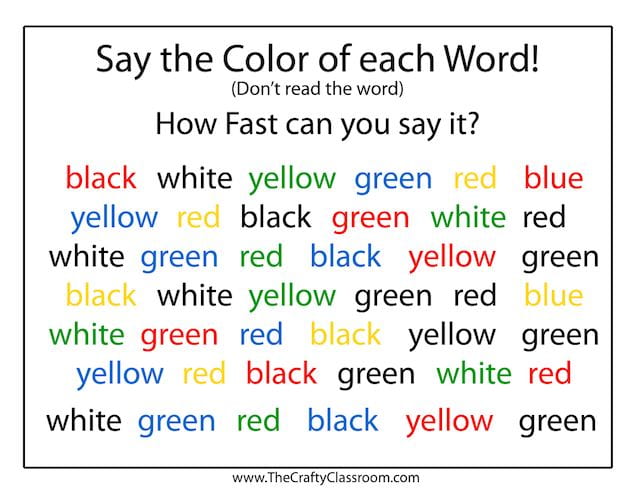

Now try it with shapes. Again call out the shape you are seeing and the colour it is.
Do not read the labels.

Finally we are back to the colours but this time can you read the words?

Take a break
Maths: Help with the tricky stuff from the work children are doing: tables, clock time, early division, rounding off

Dear Parent
We are uploading some activities here that your child may find helpful.
They are based on work being done in Maths this week and last,
particularly where children or their parents said they were finding them tricky.
So far the following has come up for mention as posing challenges:
- Angles
- Tables
- Clock time
- Early division
- Rounding off
The following are all optional and need only be used, over time if you feel they would help your child. I am posting these today, so you can plan for their possible use next week.
- I would suggest if next week your child has a problem with any of these areas in maths, they just dip in to the page and watch a video or try an activity.
- Alternatively you could take a theme at a time and do some revision work on tables, clock time, early division or rounding off using the videos and activities on this page.
Tables
The children have been doing very well at their tables. However it is the trickier tables like 7s and 8s that are posing challenges. Thank goodness for the tricks for learning the pattern of 9.
I wonder if these You Tube videos would help.
Remember, the internet is a portal to the world wide web.
Please supervise your children online.
As an adult helping children to learn their tables, I always found it interesting that 144 number facts can be reduced to 24. Just to note that the following video may be of more interest to grown ups teaching tables than the children. Also this video is more about ‘memory aids’ you can use to learn number facts than maths. But every little helps.
As a teacher and a parent I have often noticed that children get so used to a familiar voice, sometimes the novelty in someone else’s voice is enough to hold their attention longer than it would listening to a person they know well.
I think watching someone their own age rattling off the tables on You Tube is motivating for children. It gives them something to work towards.
This child for example giving tips for nine times tables.
Here is another trick for learning nines:
Pity there are so many tricks for learning the other tables.
So back to our original young teacher with his take
on learning eight times tables.
An awareness and appreciation of patterns in number work
helps children learn and love maths.
Clock Time
There have been two kinds of clock time
in the New Wave Mental Maths exercises
e.g. 10.55 is the same as 5 to 11
If you scroll down the page there are two videos from last week
about this kind of sum.
We noticed that some children were finding converting
- hours to minutes
- and minutes to hours tricky.
We will give that talented young man (Akash Vukoti) a rest
so here are two short instructional videos
that show how hours are converted to minutes:
and how minutes are converted to hours:
Early Division
Moneyville is a maths activity that has maths games for 2nd and 3rd approximately.
There is a run in, to the activity in terms of choosing the child choosing the character they would like to be.
Once a child does this and gets into Moneyville they can visit the farm which is the red building at the bottom left hand corner. On the farm there is an activity that practices division. Activities like this teaches children division as sharing:
Click HERE for Moneyville
While you are in Moneyville do call over to the island across the bridge in the top right hand corner. There is an activity there, where your child can budget for a year for a family. I know from school, that children find this enjoyable. They are surprised to see what budgeting for a household involves and it helps them see the value of money.
I would say all the other maths activities on Moneyville are more suited to younger children, though going to the shop to spend any money earned again helps children see the value of money.
To follow here is a very simple short video that explains division:
There are a lot of videos on You Tube explaining basic division.
I have selected another short, simple one
rather than an all singing, all dancing one as most appropriate
at this point for the children.
Rounding Off
Finally there were some ’rounding off’ questions during the week
and I thought it would be a good idea to revise
how to round off to the nearest 10 and 100
Click HERE is a simple online game
that gives children practice rounding off.
It is very basic but it gives the necessary practice.
And HERE. for another football themed one.
Get five correct in-a-row to take penalty shots
As we note aspects of Maths children are finding difficult
we will keep adding videos and online activities that may help.
Early Division: Division as sharing equally
Here are some online games for practicing early division. There is a variety here, so children can find one they like.

GraphicMama-team / Pixabay
Click HERE to play a game sharing small amounts equally. You will be teaching dogs some tricks.
I like this one: Doggie Division from ICT Games

pencilparker / Pixabay
Click HERE to play MONSTER DIVISION.

thejakesmith / Pixabay
If you would like to be a farmer when you grow up you might enjoy THIS one.

pencilparker / Pixabay
If you have a sweet tooth THIS one may be up your street.

AnnaliseArt / Pixabay
Guess what you’ll find in this ‘dividing as sharing equally’ activity. Click HERE
All this practice is good for your brain.
Keep it up and you will be a whizz kid at ‘dividing as sharing equally’.
Right angles, obtuse angles and acute angles
Some questions on angles have been coming up in New Wave Maths.
These short videos go back over what angles are.
You will learn about right angles, obtuse angles and acute angles.
They are optional. You may find them helpful.
You might watch this one first …
Then if you wanted to go back over what you learned
you could watch this one.
Clock time: quarter to and quarter past
Here are three short You Tube videos that go back over those tricky clock sums in New Wave Mental Maths. Watching just one a day would help children go back over how to do these sums.
Just click on ‘Skip Ads’
Revision does help. The repetition in New Wave Mental Maths helps too. Teachers find that children find this particular concept: this renaming of a clock time challenging. It happens every year. However with practice ‘the penny drops’. We call this the ‘Keep throwing mud until it sticks’ approach 😉
Scroll down this page for the videos from earlier this week
and to links for online maths activities in Clock Time and Data.
1st video on clock time
Hi there. Last week some children in 3rd class found the 1st question each day in New Wave Mental Maths hard.
It was a question about clock time. This may help. This short video explains that 5 to 5 is the same of 4.55.
Afterwards you can scroll on down for another video and some online maths games that help children to learn
clock time.
2nd video on clock time
Christmas Song from Ms. Horan’s 3rd Class
Happy Christmas to everyone. Ms. Horan’s 3rd Class hope that you enjoy their Christmas Song. Click on the link below to hear it:

geralt / Pixabay
A Spiderman fridge magnet by Cillian
Planning for Irish exemptions.
This is a document used at a staff meeting (primary) to agree on a form, class teachers will use to record differentiation and interventions used in Irish ‘over time’.
Below is the form that resulted from this ‘brainstorming’. This form can be included in the documentation that accompanies an application for an Irish exemption.
Though most schools will differentiate and intervene in similar ways there may be variations from school to school so an opportunity at a staff meeting, to talk about what might be included in this form would be useful.
As part of the new procedures for applying for an Irish exemption, we are to include a ‘paper trail’ indicating that
Class and SEN teacher have provided
– documentary evidence that the student presents with significant learning difficulties that are persistent despite having had access to a differentiated approach to language and literacy learning in both Irish and English over time are held by the school
i.e. Student Support Plans detailing
‘regular reviews of learning needs as part of an ongoing cycle of assessment,
target-setting,
evidence-informed intervention and review,
including test scores (word reading, reading comprehension, spelling, other scores of language/literacy) at key points of review.’
The student’s Student Support File (also called the Continuum of Support) will already have details of this in English – but not in Irish.
In order to put together a tick box list of differentiation/interventions/targets could we brainstorm in groups (at our class levels: Infants, 1st&2nd,3&4th, 5&6th ) answers to the following questions? LS teachers could work with the group they work most with.
- What accommodations do we put in place for a child who is struggling in Irish?
(a) differentiation
Level
Teaching style
Modifying Task
Modifying Pace
Following student’s interest
Level of Support
Resources
Response required from student.
(b) interventions
(c)targets i.e. what are our objectives with a child who finds Irish hard? What can we expect?
(d) Do we test? If so how?
This is a form that was devised at a staff meeting (Primary) that records differentiation and interventions in Irish ‘over time’ as evidence of this is required when an application for an Irish exemption is received. We will begin using this in January, and will refine it as we use it. So it is very much still in draft form.
XXX’S NS, NEWTOWN, COUNTY XXX
CHECKLIST FOR RECORDING THE DIFFERENTIATED APPROACH THAT WAS USED WITH THIS STUDENT IN IRISH, OVER TIME – IN ACCORDANCE WITH CIRCULAR 0052/2019
With regard to an application for an IRISH EXEMPTION (to be added to STUDENT’S SUPPORT FILE)
| Name of pupil | Class |
Accommodations in place for student:
| 1. | Differentiation – What has been tried? | Print ‘Yes’ where applicable |
| a) | Level
Teacher teaches to the middle & differentiates up & down. Different textbook used Same book but different expectations |
Yes
No Yes |
| b) | Teaching style
Extra instruction Over teaching Repetition Teacher models answers Teacher scaffolds oral responses |
Yes Yes Yes Yes Yes |
| c) | Modifying Task
Tasks simplified Focus on oral Irish Repetition & practice, Less output (written) expected Teacher models written response Assistance given with cloze exercises |
Yes
Yes |
| d) | Modifying Pace
Expectation of less written output Revision & repetition |
Yes |
| e) | Following student’s interests
e.g. mé féin Irish music & songs, activities & games |
Yes |
| f) | Level of Support
Teacher one to one Pair/group work Peer support/coaching |
Yes Yes Yes |
| g) | Resources
‘Bua na Cainte’ ‘Abair Liom’ (lots of useful lists at back of book) Fónaic na Gaeilge Online resources Other: |
|
| h) | Response required from student
Lower order questions in written work Lower order questions answered orally |
|
| 2. | Interventions
Focus on Oral Irish Lower level text book used Same book but different expectations Peer tutoring |
|
| 3. | Targets What are our objectives with this student who finds Irish hard?
That he/she have an appreciation of the Irish language and culture and that they enjoy Irish. That he/she continues to have opportunities to practice oral Irish, sing Irish songs, play games and activities in Irish. |
Yes
Yes |
| 4. | Assessment
Teacher observation In class feedback Photocopy examples of written work/evidence in textbook or copybook. |
Yes
Yes |
If practical, please scan a photocopy of the earliest example of the student’s written work in Irish from this year and a recent one and add this to this student’s file.
| 5. | Additional information:
e.g. X is experiencing significant difficulty in English as his test results show. Despite differentiation in Irish and intervention, he is also struggling in Irish. This is affecting his confidence. I feel he would benefit from an Irish exemption so that he could use the time to concentrate on English. I am happy that he will participate in Oral Irish and activities in Irish as I feel this is of benefit to him.
|
Signed: Class Teacher Date:
#WorldPoetryDay: I Can’t Write A Poem’ by Leon O’B
The kids in the yard are too noisy.
Are you kidding?
I fell off my chair I got cut.
And it really hurt.
I need to go to the toilet urgently enough.
Call my mom, I feel sick.
My shoes are on fire.
I swear I have nits.
I need to go home.
Or I’ll give it to the other kids.
Ding! Time’s up.
Ohno!
If my Teacher sees this
I’ll be sent out.
At least I have got some good excuses.
A Villain – A Class Poem using Metaphors – 3rd Class

![]() Jose Angel Sanchez Reyes via Compfight
Jose Angel Sanchez Reyes via Compfight
If he was a plant he would be withered.
If he was a sound he would be a slamming door.
He would be an explosion of thunder and lightning
because he is unpredictable
and raining fire, because he is in a rage.
He would be black liquorice.
and would smell like burning.
If he was a tree he would be a Whomping Willow.
He would be an icy Winter.
If he was a creature he would be a rat.
His teeth would be like the Great White Shark’s (This is a simile!)
If he was a flavour he would be bitter.
If he was a feeling he would be angry because he feels abandoned.
Poems using Metaphors from 3rd Class – Heroes & Heroines

![]() Kirt Edblom via Compfight
Kirt Edblom via Compfight
My Mum
If she was a tree she would be a blossom tree because
she makes a grey sky blue.
If she was a flower, she would be a daisy, because she is so pretty.
If she was an ice cream she would be an ice cream sundae.
If she was a sweet she would be candy floss
because she is so soft and kind.
She would be a sunny Summer’s day all year round. (Saibh)
My Hero – Lee – My Dad
If he was a tree he would be birch because he’s bright.
If he was an ice cream he would be strawberry because he has good taste.
He is sunny all year round because he is fun to play with. (Dax)
Teacher
If she was a flower she would be a tiger lily.
If she was an ice cream she would be vanilla because she is just right.
(Thanks Darcy ;))
My Mum
If she was a flower she would be a sunflower because she is strong.
If she was an ice cream she would be honey comb because she is sweet.
If she was a chocolate, she would be a smartie because she is smart. (Emily M.)
Ms. Honey (from Matilda)
If she was a tree she would be an oak because she is wise.
If she was a flower she would be a sunflower
because she is like the sun. (Caoimhe)
Matilda
If she was a candy she would be caramel because she’s super sweet.
She would be super sunny because she is all smiles. (Arkleen)



